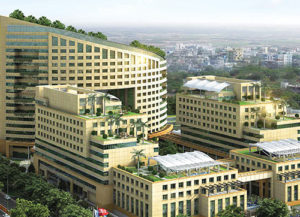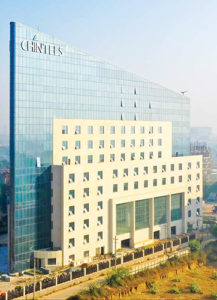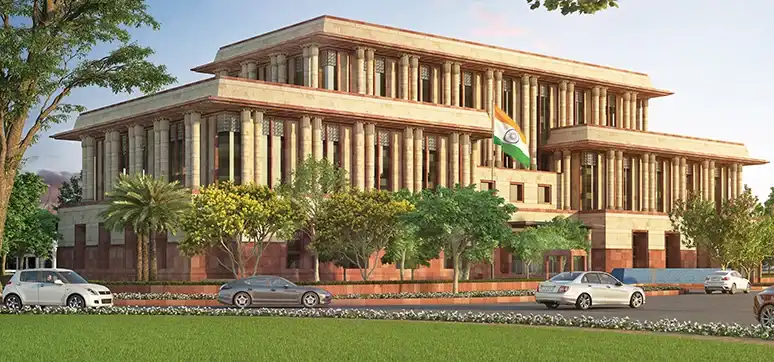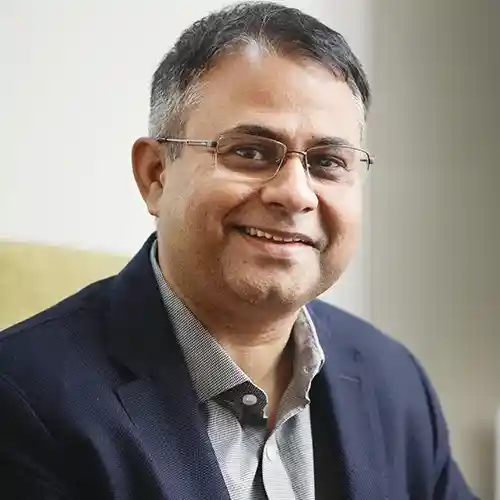In a candid conversation with WFM, Ar. Anand Sharma, one of the founding partners at DFI, gave an insight into DFI as a practice, its design approach and projects. He pushed energy efficient factors to be considered while designing building façades and fenestrations into the spotlight, which support design driven interventions and improve users’ experience. Here are the excerpts from our conversation.
Please tell us about your Practice?

After studying together and graduating from IIT Kharagpur in 1995, we started an architectural practice as collaboration and turned into partners from co-peers. Completing 25 years of our practice together with our team of professionals, we have had lifetime opportunities of working on projects reverend to the urban context and architecture of India. Our journey started with small scale residential and retail projects, and since then, our team has worked tirelessly in the spirit of service and labour of love to create a new face of architecture and urbanism for the capital city Delhi as well as for the country. Our discussion about our current projects deals with the infrastructure segment of the country, with upcoming airports, railway stations and judiciary-institutional facilities.

As the complexity of the projects increases, the domains of the verticals under which our buildings fall have been changing along with the scale of the buildings in accordance with changes in the construction industry. The evident paradigm shift in the market, from an archaic system of construction by the government alone to current trends of construction under a public-private partnership, has led to the establishment of projects that otherwise seemed to be farsighted ambitions. At present, the diverse government projects introduced will prove that ‘Design Dynamics are Evolving’. Furthering our efforts in the nation-building endeavours, including the present government’s initiative ‘Housing for All’ through the affordable housing sector, we are striving to innovate and delve into our expertise in the miscellany of domains, coherent to the current technology and design innovation.
Could you Please talk about a few of your ongoing and recently Completed Projects?

We feel privileged to see our efforts get recognised for our designs of large-scale retail projects like Select Citywalk in Saket, Delhi and other retail projects pan- India, in cities like Chandigarh, Mohali and Patiala. We also have worked extensively in the housing segment, approximately designing 30 to 40 million square feet of both affordable and luxury residential projects still date. We have also had lifetime opportunities for institutional projects; from 2012, we started moving on to institutional designs, by signing up the New Courts Block for Delhi High Court and Directorate Complex for PWD Assam. It was in the year 2015; that we made a conscious call to get into infrastructure project segments. In 2016, we started making alliances with various companies, and later in 2017, we landed our first airport project, the New Integrated Terminal Building at the Guwahati International Airport which is also the first-ever international airport in the north-eastern region of India. In addition, we also have been awarded the Amritsar Railway Station Re-development project. The year 2019 brought more opportunities for us in the infrastructural segment in the form of upcoming airport projects such as that in Bihta, Patna.
As a close observer of the Retail Market, can you please tell us about the changing trends and your approach to retail Project Design?

During the retail boom of the early 21st century, India witnessed the construction of large scale malls and retail centers when cities like Ludhiana, business districts like Gurugram (earlier Gurgaon) welcomed their first ever malls. Developers such as DLF and MGF casted these small-scale shopping centres that covered an area up to 2 – 2.5 lakh sq.ft. Whereas malls like the Garuda mall in Bangalore were inspired by the trends in Singapore, Malaysia and Dubai, they are essentially closed, inward-looking retail destinations, and adopt conventional planning including typical retail on the lower floors and food and entertainment like multiplexes on upper levels. The static retail + ‘what else’ gave the market mixed-use development (addition of residential and corporate) and large scale projects like DLF Galleria.
With the upcoming large scale malls, the closed malls were struggling to engage tenants that proved the demand for retail spaces to be more open, accessible and friendly, yet cheaper on the pocket, while the shopkeeper wanted the retail spaces with lesser maintenance charges. We have always divorced ourselves from closed floor plans in retail design and believed in the large scale format of retail projects that can house a variety of functions and appeal to the users’ as well as the customers’ experience. The way our projects function, our design approach has always been in sync with the current trends, policies and framework. For what it’s worth, to mention a few of our projects in the domain of retail and high-street model retail, JMD Suburbio and AIPL Joy Street are some of the projects in the pipeline while Silverglades Merchant Plaza at Gurugram is being readied for fit-outs.
Tell us about your projects featuring Innovative Façades and Fenestration Designs?
Context and Functionality, these are the two pillars of our design approach towards façades. If you see our institutional projects like The Delhi High Court, Vanijya Bhavan at New Delhi, Pandit Deen Dayal Upadhyaya Institute of Archaeology in Noida, you will notice that we have gravitated towards providing a functioning façade in glass combined with elements cast in traditional materials like sandstone, red sandstone and Dholpur stone inspired from the surrounding heritage buildings, assuring conceptuality. On the other hand, our corporate project Gulf Adiba at Gurugram has a fully glazed façade with an organic shape that lends a lot of variety to the façade. High energy sensitive materials have been installed in our project Cyber Walk at Manesar which is a LEED goldrated building.

Façades and cladding industries in India have gone through a sea of changes in the past decade. Tell us about the latest in façade & cladding material and technologies available in the Indian market and those used in your projects?
Very interesting question indeed! As I have observed in my 24 to 25 years of practice to date, initially, two specific materials were used for façades – ACP and glass. The design inspirations, as we know, were borrowed from the international practices; Aluminium Composite Panels (ACP) was essentially preferred irrespective of context and functionality. We have always looked for materials that are contextual, maintenance-free, ageless and aesthetically pleasing. Stone façades can have practical issues especially in larger projects.
So, we came across some good materials like porcelain and sintered slim tiles that hold importance in terms of physical properties such as minimum (almost nil) water absorption, lightweight and availability in large sizes. These are 100 percent UV resistant and easily adaptable, perhaps workable unlike the time-taking wet cladding that requires high precision. Another material called the Glass Fibre Reinforced Concrete or GFRC for façades is a versatile material, offering workability in terms of execution as well as implementation of any shape and size.
Materials like zinc and Corten steel as cladding materials provide timelessness and age well. Ceramic fritting in the glass is something that we have started using recently. Other than the innovation of materials, the guidelines and framework by Green rating for Integrated Habitat Assessment or GRIHA has revolutionised the way green buildings were imagined earlier. We make sure that our projects meet the mandatory guidelines for high Green building ratings.
What are the key factors to consider while designing the Façade and fenestration?

Elements that contribute to sustainability, the context of the surroundings, timelessness of the material, innovation or new techniques and maintainability are some of the key factors that we consider from the start, during and post-completion of a project.
People are using uPVC to some extent for fenestration. But for residential projects, people still prefer wood. Which one would you recommend and why?

uPVC is the chosen material for us owing to its properties, however, residences are heavily influenced by the owners’ personalities and taste and therefore there’s a constant conflict between functionality and aesthetics(the natural appearance of WOOD vs. manufactured appearance of uPVC). To take the middle path, many residence designers are recommending uPVC in a wooden finish. And therein lies the irony. The irony is that people want the tiles to look like stone, and stones to be blemish-free with zero variation; it is a confusing era. Natural stones will have variations and they are inherent. No stone will look alike. If it is an artificially made material, it will look artificial no matter what.
In the same way, people who want uPVC with the feel of wood are unreasonable. uPVC owns properties like it is lightweight, can be manufactured as energyefficient fenestrations, an alternative for very precious natural resources, it is cheaper and can be maintained at a reasonable cost. Looking at all these positive characters, awareness has to be created for uPVC to be accepted in its full originality.
Please brief on the technical factors which help to build energy-efficient façades and fenestration?

Technical energy simulation and modeling is the first step towards building energy-efficient façades. Façades of a building should be designed based on the orientation of the building. If it is glass, the Pandit Deen Dayal Upadhyaya Institute Of Archeology, Greater Noida glasses on different façades have approaches to design a building under a passive approach. The architect has to keep sustainability at the back of his mind while designing any building; it is purely driven by climate, weather and little attention.
In terms of active approach, green buildings are about energy conservation, water conservation, using materials that come from without destruction of the environment. There are existing laws by which the government needs to be followed to a large extent. Environmental clearance is one of them. Most of the criteria for green building will be met if we follow the laws. One cannot plan a project without a proper sewage treatment plant or rainwater harvesting. GRIHA rating holds more importance for corporate sectors and it has to be between 1 to 5 stars. If you are aiming to get the environmental clearance from the ministry of environment and forests, you can’t miss a 3-star rating. 4 stars is a bit tougher and getting a 5-star rating is a huge effort and so are the Silver, Gold and Platinum LEED rating from GBC.
Corporate or high-end residential projects can afford to go the fivestar route. Some government buildings can earn Griha 5-star, while most go for Griha 4-star. Extra investment is required for a 5-star or Platinum rating. But the return on investment, by reducing maintenance and operational costs, is much higher in a 5-star or Platinum rated building.
What is the kind of awareness your clients have on the usage of sustainable façade and fenestration materials?
It depends on the segment of the building. When we talk about individual houses, they want whatever is best globally and locally. The construction industry is maturing and materials are globally available. There has been a dynamic innovation especially in corporate and their high-end or large-scale projects. While ACP was available at Rs.300/Sq f, it offered high maintenance costs. Therefore, the corporate started looking for materials in the same price bracket but opted for those that were long-lasting, and timeless with least maintenance. Maximum changes are happening in Government projects. They are changing from drab to fab buildings. There are very few government buildings built by classy architects like B.V. Doshi, Charles Correa, Raj Rewal or Kanvinde, which are still beautiful pieces of architecture.
Therefore, the biggest changes or awareness has come in the Government buildings due to two reasons:
1. The available budgets, which is far more than what real-estate developers spend on their buildings
2. All architects who were not doing Government buildings are all going for such projects, including the big design firms.
The public-private relationship has led to a better quality of end products of the projects What is your advice to young, aspiring architects?

I think our generation grew up looking at government buildings which were drab and houses with very or no semblance of architecture except in the architecturally important heritage buildings. The design was very low on priority. With liberalisation in the mid ’90s, things have changed; the first reaction was to copy international designs. Therefore, all the works that had happened during the early 2000s have mostly been copied from western countries. All modern buildings, whether in Mumbai, Bangalore, Gurugram, Singapore or Dubai, built during that time are similar looking. This was definitely not the way to go!
But in the last 8 to 10 years, architects have started to realise that we have a mind of our own with our rich culture and traditions and vernacular architecture, and there are lessons to be learned from them. We don’t need to copy- but need to learn from our traditional past. My advice to the young architect is to not to get swayed by a trend or a fad. But think for themselves. Do research and design as per the requirement. This is what is taught by our professors in the colleges – “Think globally and act locally”, and this is still very relevant.














